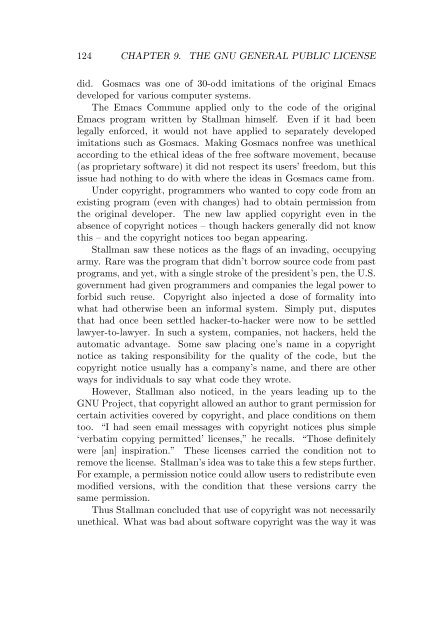You also want an ePaper? Increase the reach of your titles
YUMPU automatically turns print PDFs into web optimized ePapers that Google loves.
124 CHAPTER 9. THE GNU GENERAL PUBLIC LICENSE<br />
did. Gosmacs was one of 30-odd imitations of the original Emacs<br />
developed for various computer systems.<br />
The Emacs Commune applied only to the code of the original<br />
Emacs program written by Stallman himself. Even if it had been<br />
legally enforced, it would not have applied to separately developed<br />
imitations such as Gosmacs. Making Gosmacs nonfree was unethical<br />
according to the ethical ideas of the free software movement, because<br />
(as proprietary software) it did not respect its users’ freedom, but this<br />
issue had nothing to do with where the ideas in Gosmacs came from.<br />
Under copyright, programmers who wanted to copy code from an<br />
existing program (even with changes) had to obtain permission from<br />
the original developer. The new law applied copyright even in the<br />
absence of copyright notices – though hackers generally did not know<br />
this – and the copyright notices too began appearing.<br />
Stallman saw these notices as the flags of an invading, occupying<br />
army. Rare was the program that didn’t borrow source code from past<br />
programs, and yet, with a single stroke of the president’s pen, the U.S.<br />
government had given programmers and companies the legal power to<br />
forbid such reuse. Copyright also injected a dose of formality into<br />
what had otherwise been an informal system. Simply put, disputes<br />
that had once been settled hacker-to-hacker were now to be settled<br />
lawyer-to-lawyer. In such a system, companies, not hackers, held the<br />
automatic advantage. Some saw placing one’s name in a copyright<br />
notice as taking responsibility for the quality of the code, but the<br />
copyright notice usually has a company’s name, and there are other<br />
ways for individuals to say what code they wrote.<br />
However, Stallman also noticed, in the years leading up to the<br />
GNU Project, that copyright allowed an author to grant permission for<br />
certain activities covered by copyright, and place conditions on them<br />
too. “I had seen email messages with copyright notices plus simple<br />
‘verbatim copying permitted’ licenses,” he recalls. “Those definitely<br />
were [an] inspiration.” These licenses carried the condition not to<br />
remove the license. Stallman’s idea was to take this a few steps further.<br />
For example, a permission notice could allow users to redistribute even<br />
modified versions, with the condition that these versions carry the<br />
same permission.<br />
Thus Stallman concluded that use of copyright was not necessarily<br />
unethical. What was bad about software copyright was the way it was


